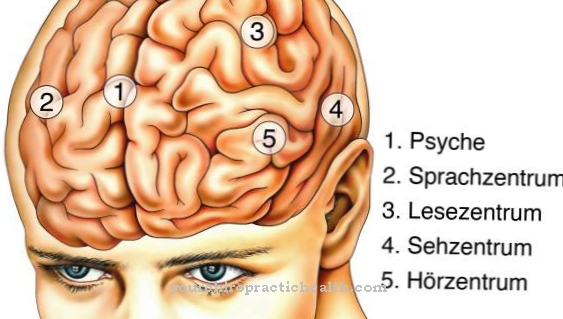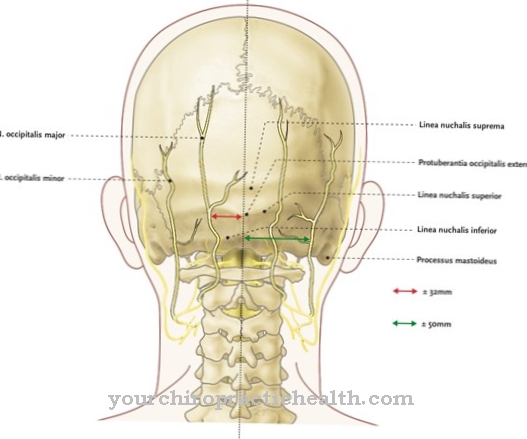The gray matter is an important part of the central nervous system and significantly determines its functions. The intelligence capabilities of the brain are particularly associated with gray matter. However, in addition to intelligence, it controls all perceptual processes and human motor performance.
What is the gray matter?
The central nervous system is made up of both gray and white matter. In contrast to the white, the gray matter consists of the actual cell bodies of nerve cells (neurons) and glial cells. The white matter, on the other hand, consists of the nerve fibers, the axons, which are surrounded by membranes.
The neurophile and the capillaries are still located between the nerve and glial cells. The actual processing of the central nervous system takes place in the neurons. The glial cells play a supporting role. But they are not involved in the transmission processes of the nervous system. The neurophile as a so-called nerve felt ensures that the individual cells are connected to one another. After all, the capillaries are responsible for supplying the cells with oxygen and nutrients. The designation gray matter results from the gray coloration of the preparations preserved in formalin in these areas.
However, the gray matter in living organisms does not appear gray, but pink. The gray matter is present in all parts of the central nervous system. This applies equally to the brain, spinal cord and nerve tracts.However, the two components gray and white matter are arranged differently in the individual areas of the nervous system.
Anatomy & structure
There are three different ways of arranging the gray matter. It should always be noted that it always occurs together with the white matter. The white matter represents an area that mainly contains the nerve fibers of the neurons.
The actual cell bodies collect in the gray matter area. In the brain, the gray matter is on the periphery. The so-called cortex, the cerebral cortex, consists of gray matter, while inside the cerebrum the white matter is located as the cerebral medulla. Both the cerebrum and the cerebellum are surrounded by a cortex made of gray matter. In various other areas of the brain there are nuclei of gray matter surrounded by white matter. This is especially true of the diencephalon and the brain stem. In the spinal cord, the gray matter is inside. That is where the white matter is on the outside.
It has been found that the amount of gray matter in the brain correlates with intelligence and all other brain functions. However, due to a lack of space, the brain cannot expand indefinitely. The biological solution consists in an increasingly complex folding of the cerebral cortex. In doing so, its surface is enlarged, whereby the gray matter finds more space. The human cortex contains between 19 and 23 billion nerve cells, the connections between which determine large parts of the brain's performance.
Function & tasks
The gray matter controls all brain functions as well as all functions of the central nervous system. The cerebral cortex is responsible for several basic functions. It consists of four lobes called the frontal, parietal, temporal and occipital lobes.
The frontal lobe controls motor processes, motivation, drive and psychological performance. The three other lobes mainly process the signals from the sensory organs. The parietal lobe is responsible for contact stimuli. The temporal lobe processes all acoustic and the occipital lobe all optical stimuli. The cerebellar cortex controls balance and coordination. Basic control mechanisms are processed in the brain stem. The diencephalon transmits signals to the cerebrum. It consists of nuclei of gray matter that function as the thalamus, hypothalamus, epithalamus, and subthalamus.
The thalamus plays a special role in signal transmission to the cerebrum. In the spinal cord, the gray matter is responsible for the motor functions of the skeletal muscles and for the sensitivity of the nerve cells. The fiber bundles of nerve cells are guided through the spinal canal in the form of nerve cords. Inside these nerve bundles is the gray matter. The fiber bundles split in an H-shape into a front and a rear column. The front pillar is known as the motor front root and the rear pillar as the sensitive back root due to its function.
Diseases
When certain parts of the central nervous system fail, characteristic symptoms of failure result. In the cerebral cortex, there are many areas next to each other that perform quite different functions.
Local injuries or illness-related failures can lead to partial disruptions in perceptual processes. For example, if the visual center is destroyed, blindness occurs even though the eyes are fine. The visual stimuli are passed on from the eye to the brain, but processing of the optical impressions is no longer possible in this case. If higher bark fields fail, the patient can see but can no longer recognize the movements, colors or faces. When the Broca center is damaged, the ability to speak is severely impaired. However, language understanding does not suffer.
Damage to the frontal lobe can lead to decreased intelligence and changes in personality. Damage to certain areas of the brain can result from injuries, strokes or other disease processes. Damage to the spinal cord, in turn, is often the cause of symptoms of paralysis and paraplegia, as its nerve cords are responsible for the motor functions of the skeletal muscles.
Such damage occurs as a result of injuries or pinching of nerves as part of a herniated disc. In the case of nerve entrapment, temporary symptoms of paralysis can occur, which usually disappear again after the cause has been eliminated. In severe cases, however, paraplegia can develop here due to the death of nerve fibers.




.jpg)






















